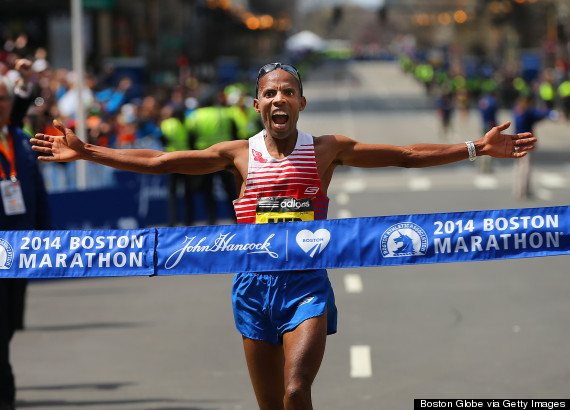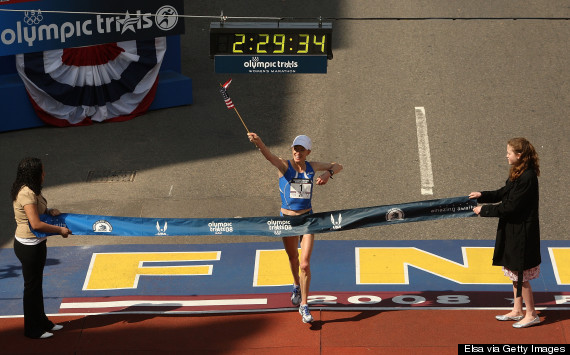By Jordan Shakeshaft for Life by DailyBurn
For Meb Keflezighi it happened at mile 15 of the 2014 Boston Marathon, when he surged ahead of the pack and stayed there for the next 11 miles, crossing the storied finish line 12 seconds ahead of Kenya's Wilson Chebet. Prior to Boston, the fastest Keflezighi had run the 26.2 miles was at the 2012 Olympic trials, finishing in 2:09:08. At age 38, one month shy of his 39th birthday, and one year after the tragic bombings on Boylston Street, Meb ran the most important race of his life, in 2:08:37.
For Deena Kastor it happened somewhere along the River Thames, retracing the route that earned her an American record three years prior. This time, at the 2006 London Marathon, she had two even loftier goals: Run it in under two hours and 20 minutes, and win the race. Not only did she accomplish both, she was the first woman to break 2:20:00 with a 2:19:36 finish that smashed her previous American record by nearly two minutes. At the end of the year, Kastor was ranked #1 in the world.

A Winning Approach
Personal bests, personal records (PRs), the best days ever... Whatever you call them, the good news is they're not just reserved for the elites. What each one has in common: That moment when the training, the execution -- and sometimes a touch of magic -- all come together to reward you at the finish line.
So how is a PR goal set, tackled, and, if all goes according to plan, accomplished? "Getting the best out of ourselves takes sacrifice and commitment, no question ... You have to dare to do something different, something memorable," says Keflezighi, who paced runners of all levels to break 1:45 in the Rock 'n' Roll Las Vegas Half-Marathon in November.
Whether your goal is to qualify for Boston or to finish your first 5K in under 30 minutes, these tips from Keflezighi (Olympic silver medalist, reigning Boston Marathon champion, and American record holder) and Kastor (Olympic bronze medalist and 12-time American record holder) will help make your PR aspirations a reality. Of course, it's up to you (and a willing training partner or two) to put in the work!
1. Set Multiple Goals
While it's natural to want to go after that one big, all-or-nothing goal, it's important to anticipate circumstances out of your control. "You should always have an A, B and C goal," Keflezighi recommends. During the 2014 New York City Marathon, he says his objectives were A) to run a personal best, B) to win and C) to make the podium. Though the heavy winds put a wrench in plan A, there were still two other goals to chase down. "You have to think positive," says Keflezighi. "I was in 8th place with three or four miles to go, and I ended up just one place shy of the medal, so you have to be proud of that."
2. Plan Your Attack
If you're serious about PRing, you'll need a serious training plan to match. "I think having a coach, believing in a program, and committing to follow it allows you to consistently build the athlete within," Kastor says. Though a good pro won't come cheap, even just one or two online consultations can be a great starting point to assess where you're at and how to start building out your next eight to 16 weeks of workouts. Don't have the budget to invest in coaching? Runner's World offers digital training plans for just about every distance and ability level (starting at $20), and apps like RunKeeper and Nike+ Running provide some for free.
3. Vary Your Workouts
"People often say, 'Oh, I'm a marathoner -- I'm just going to go the same pace,'" says Keflezighi, "but there are so many other things you can do to help you improve [come] race day." When it feels as though your training is about to plateau, shake things up a bit. "Shorten your speedwork and get more aggressive, or find a new trail to explore," Kastor suggests.
New to intervals? It can be as simple as "One minute hard, three minutes easy, two minutes hard, five minutes easy," says Keflezighi, "Or run a block; jog a block. It's all about changing mechanics."

4. Feed The Machine
Don't underestimate nutrition -- it's one of the greatest assets a runner has, Kastor says. "Even for general health, it is important to eat a large amount of high-quality food. I always choose organic, fresh, grass-fed, whole-grain foods." If you're tacking on more miles, she suggests having plenty of healthy snacks around, too, so you don't turn to junk food when runger strikes. "I love keeping roasted nuts, fresh fruit and homemade kale or spinach chips on the counter for me and my family," the ASICS Marathoner says.
5. Change Terrain
It's no surprise that more mileage can mean an increased risk of injury. (Reminder: Injured runners won't make it to the start line, let alone PR). One way to minimize the impact? Seek out softer ground, like dirt or grass, to give your body a break from the pounding. "I recommend doing at least half your runs on soft surfaces, and the other half on pavement, just to get used to it," Keflezighi says. Bonus: Venturing onto new land will help develop underutilized muscles, which can in turn increase power, he adds.
6. Cross-Train (With Care)
Meb credits staying strong and injury-free to cross-training, which can include up to four hour-long workouts a week on the low-impact ElliptiGO. Aquajogging, swimming and biking can be great options too, he says. As for strength work: "Even if it's just five to 10 minutes a day, it can sometimes be more beneficial to do that than squeezing in that extra mile," says Keflezighi, who sticks to mostly bodyweight training.
And while there's a big movement towards strength training, don't expect to find Kastor at a bootcamp or CrossFit box anytime soon. "I don't believe in cross-training to help running. I believe running makes you better at running." You can, however, find Kastor, along with her ASICS Mammoth Track Club teammates, at the gym for about 40 minutes of dynamic movement a day. "Leg swings, walking lunges, step-ups and prone eagles all help to increase mobility so we can run freely."
7. Get More Sleep
While runners need to run, they also need to rest. "I don't believe in overtraining, but I believe many people can become under-rested," Kastor says. "If you are adding mileage to your program, make sure you also add some recovery time, like going to bed 30 minutes earlier. Mileage is important, but so is rest." During sleep, since muscles remain relaxed, the body is best able to repair broken-down tissue. Those extra Zzs will help keep your legs -- and your mind -- fresh for the challenges ahead.
8. Know Your Gear
Over the course of your training, you'll have no doubt bought-out your local running store, trying various GUs, gadgets and gear. But as race day nears, you'll want to settle on your go-to's. For Kastor, that's the ASICS GEL-Hyper Speed racing flats and a hat. "It keeps the elements off my face so my facial muscles can stay relaxed. Whether its sunny, windy or rainy I find a cap protects and acts as blinders [in order to focus on] the road ahead." Learn what works for you, and never (never!) try anything new on race day -- especially shoes!

9. Retrace Your Steps
In the weeks leading up to the big day, some combination of excitement and nerves is inevitable. Instead of letting your emotions get the better of you, take a few moments to quiet your mind and think back on your journey. "I always look at my training log and reflect on some of the longer, tougher and fastest workouts I accomplished leading up to race day," says Kastor, who writes regularly in her Believe Training Journal.
Be sure to also look ahead, Keflezighi adds. "You know it's going to be challenging; you know it's doing to be difficult. But you have to think about why you started doing it, and all the sacrifices you've made along the way ... waking up early to put in 28 miles, 27 miles, 26 miles. You made it all this way -- you have to be ready to maximize it."
10. Live The Moment
"My best races are the ones where I take it all in; not just my training, but the history, scenery and the crowds," Kastor says. "The [London] course was a stunning tour of an enchanting city, so rich in history that I wanted to enjoy tea sandwiches and crumpets with the queen afterwards." During the race, don't be afraid to take a break from checking your splits to soak in your surroundings.
"Road racing is not like other sports -- to be so close to other runners, and right next to the crowds," Keflezighi says. "Just one person can have a positive impact by pushing the pace, or giving a thumbs up, or acknowledging that you're there. Being able to interact with the crowd is the real beauty of road racing." Let the energy fuel you -- you might just avoid hitting a wall in the final stretch ahead.
11. Run With Patience
PRs don't just hinge on speed, they require patience -- especially at the beginning, Keflezighi says. "Don't get too excited and put everything into the first 10 miles of the half-marathon, or the first 17 to 18 miles of a marathon. If you can negative split, or try to stay even, then you have a better chance of a faster finish." Determine your race pace before the gun goes off, and avoid letting those inevitable jitters re-jigger your plan.
12. Run To Win
If you don't believe in yourself, then who else will? "I always say, 'run to win.' You get first place by seizing the moment and trying to get the best out of yourself," says Keflezighi. No matter what the course has in store for you, lay it all out there and have some fun in the process. "Get to that finish line as strong as you can but also with a smile on your face."

More from Life by DailyBurn:
The 50 Best Half-Marathons in the U.S.
8 Killer Treadmill Classes (Plus Cardio Workouts to Try Now!)
The 20 Worst People at the Gym, According to Trainers